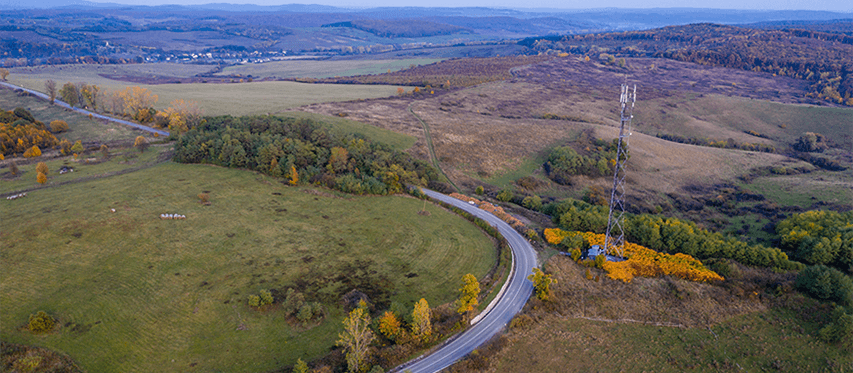5 for 50: Milestones in Mobility

To celebrate 50 years of Hughes innovation and leadership this year, many of my Hughes colleagues have been sharing personal insights as part of a “5 for 50” series. While they have discussed turning points in government telecom and e-commerce, I have chosen to reflect on something many of us take for granted every day, everywhere we go – and that is the smart phone, which you likely have in your hand and may even be using to read this right now. Mobile communications and its many advancements over five decades are the foundation for 5G technologies and networks rolling out now.
Here are five innovations in mobile communications – without which, many aspects of our lives today would be very different, and the capabilities we’ll enjoy tomorrow would not be possible.
-
1973-1983–Who’s calling please? The mobile phone debuts. Car phones went to market in 1979, a few years after the first successful call was made in 1973. But early mobile phone models were clunky and expensive; they were installed in cars, rather than carried around by users. One of the obstacles to widespread adoption was the size and weight of batteries. In 1983, when lithium-ion batteries were introduced, phone size and weight were reduced by more than half. By 1983 there was enough network infrastructure built to support widespread cellular service. During the same time span, COMSAT launched three geostationary satellites to provide multiband communications between seaborne vessels and shore stations, enabling the U.S. Navy and other customers to provide mobile services to personnel at sea.
-
1990s–The dawning of the digital age. In the 1990s, the Global System for Mobile Communications (GSM) was released, providing international standards and protocols for second generation (2G) digital cellular networks. GSM technology marked the shift from analog to digital communications – making basic text messaging possible. New technologies and networks soon enabled users to send graphics-rich data as well. In 1996, Hughes introduced satellite Internet service for consumers and small businesses—in what would become the company’s flagship HughesNet® service. In addition, Hughes built the first digital cellular network for BellSouth that same decade.
-
2000–Text me! Millions of texts are sent each day. By 2000, Americans were sending 35 texts per month. Just two years later, more than 250 billion SMS messages were sent worldwide. Then, with the introduction of the Blackberry smartphone in 2003 and its keyboard device, both text messaging and email exploded. Blackberry became the device of choice for corporations because of its enterprise security, business functionality and the ability to type longer messages rapidly. In 2001, Hughes introduced a satellite phone to support voice service on the Thuraya Mobile Satellite System (MSS), utilizing the Hughes developed air interface—which became the global standard, known as GMR-1. Hughes then added IP data capability for the Thuraya and Inmarsat MSS networks in 2003.
-
2007—The iPhone Arrives. The evolution from cell phones of the 1990s to smartphones took time. But when Apple released its first-generation iPhone, it revolutionized the industry and opened the gates for increased e-commerce activity and eventually the app economy. The increasing reach and availability of 3G networks was also crucial. Not only did 3G offer faster speeds but 3G operators often expanded data limits for users. On the satellite side, between 2008 and 2012, Hughes evolved the GMR-1 standard to GMR-1 3G, delivering high-speed data in addition to voice and other 3G equivalent services. These benefitted multiple mobile satellite networks, including GEO and LEO systems (Mexsat, TerreStar, and Globalstar) and other service providers. Users accessed networks with handsets, as well as vehicular, semi-fixed, portable, maritime, and aeronautical satellite terminals.
-
2015 and Beyond–Everyone, everything, everywhere is connected. By 2015, every aspect of our daily lives is influenced by our ability to be mobile and stay connected. Community Wi-Fi hotspots make it possible for customers in restaurants, coffee shops, and hotels to access the Web. And service is no longer limited to densely populated or urban areas; satellite brings hotspot connectivity to those who live in rural areas unserved or underserved by terrestrial broadband. Aero, land-mobile and maritime mobility solutions with next generation satellite systems also make accessing broadband Internet services a reality while in the air, on trains, in vehicles or over open waters.
By the end of 2021, 35 billion devices will be connected to the Internet every minute—and yet, there are still 3.6 billion people without Internet, in part due to lack of coverage and access. But as 5G is deployed in urban areas and the number of users and devices continues to explode, rural areas will benefit as network operators extend cell towers and improve their 3G, 4G, and LTE services. Then in much the same way, 5G will be superseded eventually by 6G capabilities (which are already being mapped out) and Hughes will continue to develop new technologies and services. Not only will more people and more things get connected—we’ll all be able to stay connected in more places – and more ways – than ever before.